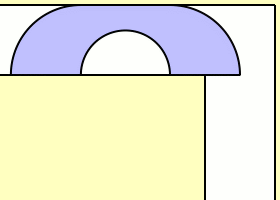Moving sofa problem
What is the largest area of a shape that can be maneuvered through a unit-width L-shaped corridor?
In mathematics, the moving sofa problem or sofa problem is a two-dimensional idealisation of real-life furniture-moving problems and asks for the rigid two-dimensional shape of largest area A that can be maneuvered through an L-shaped planar region with legs of unit width.[1] The area A thus obtained is referred to as the sofa constant. The exact value of the sofa constant is an open problem.
History[]
The first formal publication was by the Austrian-Canadian mathematician Leo Moser in 1966, although there had been many informal mentions before that date.[1]
Lower and upper bounds[]
Work has been done on proving that the sofa constant cannot be below or above certain values (lower bounds and upper bounds).
Lower bounds[]


An obvious lower bound is . This comes from a sofa that is a half-disk of unit radius, which can rotate in the corner.
John Hammersley derived a lower bound of based on a shape resembling a telephone handset, consisting of two quarter-disks of radius 1 on either side of a 1 by 4/π rectangle from which a half-disk of radius has been removed.[2][3]
Joseph Gerver found a sofa described by 18 curve sections each taking a smooth analytic form. This further increased the lower bound for the sofa constant to approximately 2.2195.[4][5]
A computation by Philip Gibbs produced a shape indistinguishable from that of Gerver's sofa giving a value for the area equal to eight significant figures.[6] This is evidence that Gerver's sofa is indeed the best possible but it remains unproven.
Upper bounds[]
Hammersley also found an upper bound on the sofa constant, showing that it is at most .[1][7]
Yoav Kallus and Dan Romik proved a new upper bound in June 2017, capping the sofa constant at .[8]
Ambidextrous sofa[]

A variant of the sofa problem asks the shape of largest area that can go round both left and right 90 degree corners in a corridor of unit width. A lower bound of area approximately 1.64495521 has been described by Dan Romik. His sofa is also described by 18 curve sections.[9][10]
See also[]
- Dirk Gently's Holistic Detective Agency – novel by Douglas Adams, a subplot of which revolves around such a problem.
- Mountain climbing problem
- Moser's worm problem
- "The One with the Cop" - an episode of the American TV series Friends a subplot revolving around such a problem.
References[]
- ^ a b c Wagner, Neal R. (1976). "The Sofa Problem" (PDF). The American Mathematical Monthly. 83 (3): 188–189. doi:10.2307/2977022. JSTOR 2977022.[dead link]
- ^ Croft, Hallard T.; Falconer, Kenneth J.; Guy, Richard K. (1994). Halmos, Paul R. (ed.). Unsolved Problems in Geometry. Problem Books in Mathematics; Unsolved Problems in Intuitive Mathematics. II. Springer-Verlag. ISBN 978-0-387-97506-1. Retrieved 24 April 2013.
- ^ Moving Sofa Constant by Steven Finch at MathSoft, includes a diagram of Gerver's sofa.
- ^ Gerver, Joseph L. (1992). "On Moving a Sofa Around a Corner". Geometriae Dedicata. 42 (3): 267–283. doi:10.1007/BF02414066. ISSN 0046-5755. S2CID 119520847.
- ^ Weisstein, Eric W. "Moving sofa problem". MathWorld.
- ^ Gibbs, Philip, A Computational Study of Sofas and Cars
- ^ Stewart, Ian (January 2004). Another Fine Math You've Got Me Into... Mineola, N.Y.: Dover Publications. ISBN 0486431819. Retrieved 24 April 2013.
- ^ Kallus, Yoav; Romik, Dan (December 2018). "Improved upper bounds in the moving sofa problem". Advances in Mathematics. 340: 960–982. arXiv:1706.06630. doi:10.1016/j.aim.2018.10.022. ISSN 0001-8708. S2CID 5844665.
- ^ Romik, Dan (2017). "Differential equations and exact solutions in the moving sofa problem". Experimental Mathematics. 26 (2): 316–330. arXiv:1606.08111. doi:10.1080/10586458.2016.1270858. S2CID 15169264.
- ^ Romik, Dan. "The moving sofa problem - Dan Romik's home page". UCDavis. Retrieved 26 March 2017.
External links[]
- Romik, Dan (March 23, 2017). "The Moving Sofa Problem" (video). YouTube. Brady Haran. Archived from the original on 2021-12-21. Retrieved 24 March 2017.
- SofaBounds - Program to calculate bounds on the sofa moving problem.
- A 3D model of Romik's ambidextrous sofa
- Discrete geometry
- Unsolved problems in geometry
- Recreational mathematics
- 1966 introductions




